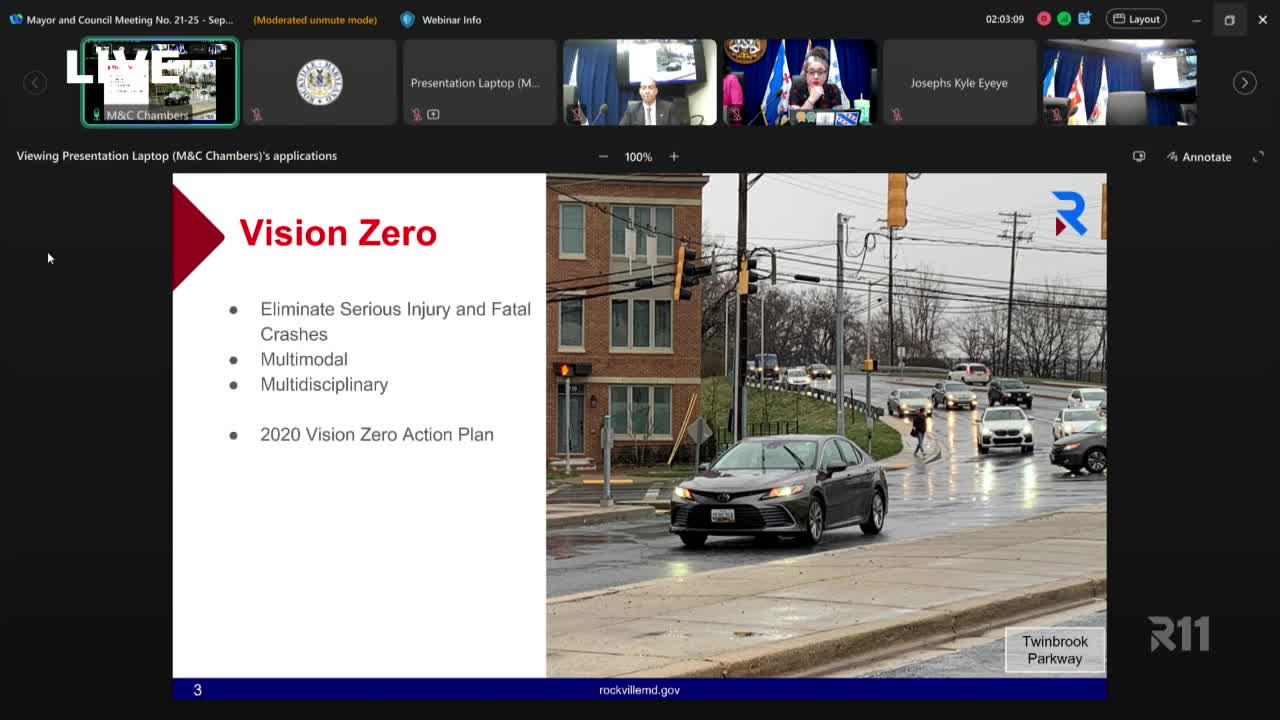Rockville City Council reviews Vision Zero program and road safety improvements
September 08, 2025 | Rockville City, Montgomery County, Maryland
This article was created by AI summarizing key points discussed. AI makes mistakes, so for full details and context, please refer to the video of the full meeting. Please report any errors so we can fix them. Report an error »

The Rockville Mayor and Council meeting on September 8, 2025, focused on the city's ongoing efforts to enhance transportation safety and accessibility through the Vision Zero initiative. This comprehensive program aims to eliminate traffic-related fatalities and serious injuries by addressing the needs of all road users, including drivers, cyclists, pedestrians, and transit riders.
Key discussions included an update on crash data, revealing a slight increase in serious injury crashes in 2025 compared to previous years, with eight incidents reported in the first half of the year. The council emphasized the importance of updating the high injury network, which identifies road segments with frequent serious crashes. Notably, improvements on North Washington Street, including lower speed limits and new bike lanes, have resulted in a significant reduction in serious injuries since the project's completion.
The meeting also highlighted ongoing safety enhancements at the Veers Mill Road and Atlantic Avenue intersection, where recent pedestrian crashes prompted further evaluations for additional safety measures. The Maryland Department of Transportation has been engaged to explore options such as restricting left turns and right turns on red during peak hours.
Public engagement remains a priority, with the city actively participating in community events to promote the Vision Zero program. The council encouraged residents to reach out for information and support regarding safety initiatives and sidewalk requests. Recent efforts have led to the installation of new sidewalks and crosswalks, with a focus on accessibility improvements in line with federal guidelines.
Additionally, the council discussed the installation of LED streetlights to improve visibility and safety for all road users. The city is also advancing bicycle facilities, including fix-it racks for cyclists and separated bike lanes on key routes.
In conclusion, the meeting underscored Rockville's commitment to creating safer streets through collaborative efforts with state and county agencies, ongoing public engagement, and data-driven decision-making. The council expressed optimism about the positive impact of these initiatives on community safety and mobility.
Key discussions included an update on crash data, revealing a slight increase in serious injury crashes in 2025 compared to previous years, with eight incidents reported in the first half of the year. The council emphasized the importance of updating the high injury network, which identifies road segments with frequent serious crashes. Notably, improvements on North Washington Street, including lower speed limits and new bike lanes, have resulted in a significant reduction in serious injuries since the project's completion.
The meeting also highlighted ongoing safety enhancements at the Veers Mill Road and Atlantic Avenue intersection, where recent pedestrian crashes prompted further evaluations for additional safety measures. The Maryland Department of Transportation has been engaged to explore options such as restricting left turns and right turns on red during peak hours.
Public engagement remains a priority, with the city actively participating in community events to promote the Vision Zero program. The council encouraged residents to reach out for information and support regarding safety initiatives and sidewalk requests. Recent efforts have led to the installation of new sidewalks and crosswalks, with a focus on accessibility improvements in line with federal guidelines.
Additionally, the council discussed the installation of LED streetlights to improve visibility and safety for all road users. The city is also advancing bicycle facilities, including fix-it racks for cyclists and separated bike lanes on key routes.
In conclusion, the meeting underscored Rockville's commitment to creating safer streets through collaborative efforts with state and county agencies, ongoing public engagement, and data-driven decision-making. The council expressed optimism about the positive impact of these initiatives on community safety and mobility.
View full meeting
This article is based on a recent meeting—watch the full video and explore the complete transcript for deeper insights into the discussion.
View full meeting
